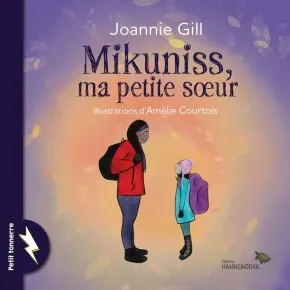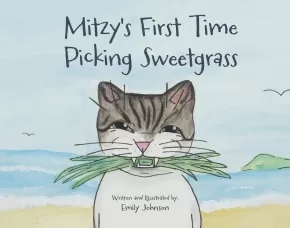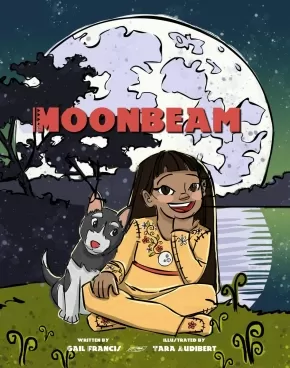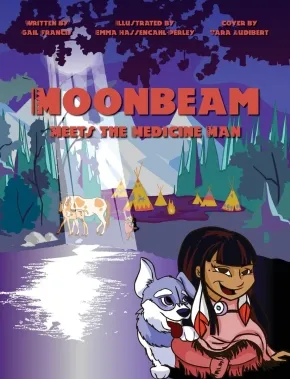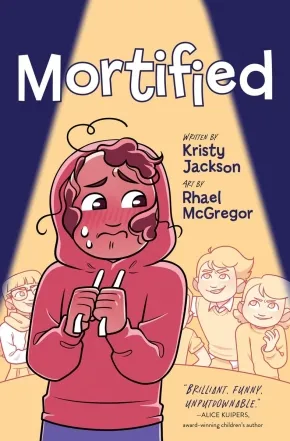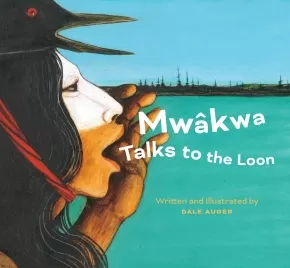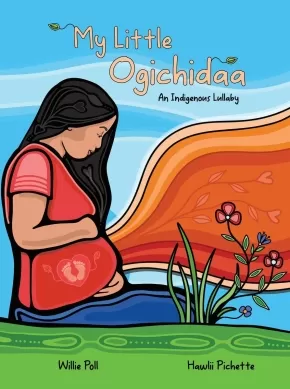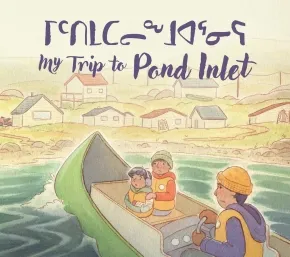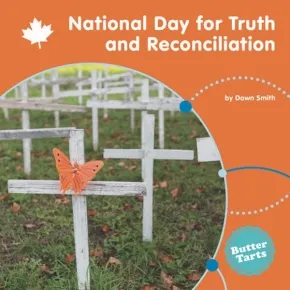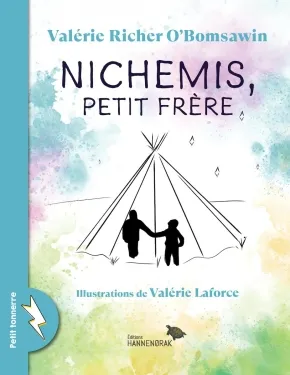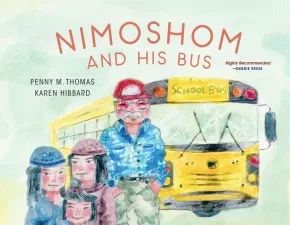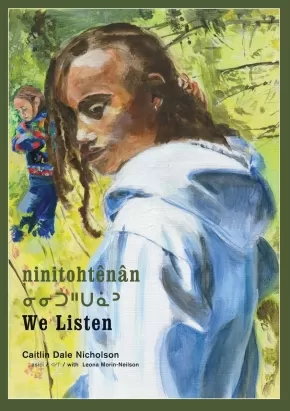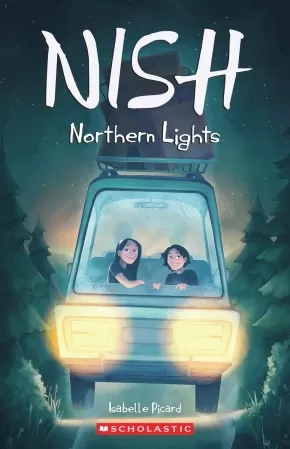
Kids Book
301
-
315
of
1993 Results;
Sort By
Go To
of 133
Mikuniss, ma petite soeur
$16.95
Artists:
Format:
Paperback
Text Content Territories:
Indigenous Canadian; First Nations; Innu (Montagnais-Naskapi); Mashteuiatsh (Pekuakamiulnuatsh);
ISBN / Barcode: 9782925118558
Synopsis:
Synopsis:
À quelques jours du début de l’école en territoire, Lora raconte à sa petite sœur, Mikuniss, l’histoire entourant son prénom. Avec Mikuniss, ma petite sœur, Joannie Gill nous offre le premier de trois albums sur les prénoms décolonisés.
Educator & Series Information
Juvenile Fiction
This book is part of the Petit tonnerre series.
Mitzy's First Time Picking Sweetgrass
$14.95
Artists:
Format:
Paperback
Text Content Territories:
Indigenous Canadian;
ISBN / Barcode: 9781777854287
Synopsis:
Synopsis:
This book is about a curious kitty who gets to experience her first time sweetgrass picking with her mom.
Educator Information
Recommended for ages 4 to 6.
Additional Information
28 pages | 9.25" x 7.28" | Paperback
Moonbeam
$14.95
Format:
Paperback
Text Content Territories:
Indigenous Canadian; First Nations; Wolastoqiyik (Maliseet);
ISBN / Barcode: 9781777854294
Synopsis:
Synopsis:
How did you get your name? Who named you? Why were you given your name? How do we name our children? Using the traditional practice of naming children, this first story about Moonbeam is the story of how she got her name. She tags along with her mother Morning Star to deliver a baby and she tries to guess the new baby’s name.
Awards
- 2020 Dr. Marilyn Trenholme Literacy Award for Outstanding Effort in Indigenous Literacy winner
- 2023 Lieutenant-Governor's Award for High Achievement in the Arts
Reviews
“This altogether lovely story takes us into the heart of family and community. The naming of things is the claiming of things. The arrival and naming of a child is celebration!” - Sheree Fitch – Canadian Author
Educator & Series Information
Recommended for ages 4 to 10.
This book is the first book in the Moonbeam series, followed by Moonbeam Meets the Medicine Man.
Additional Information
28 pages | 7.28" x 9.25" | Paperback | 2nd Edition
Moonbeam Meets the Medicine Man
$22.95
Format:
Hardcover
Text Content Territories:
Indigenous Canadian; First Nations; Wolastoqiyik (Maliseet);
ISBN / Barcode: 9781998223091
Synopsis:
Synopsis:
Traditionally, the Medicine Man was a healer that people in the village would consult in times of spiritual or physical need. When Moonbeam starts to have nightmares, her friends introduce her to the Medicine Man who gives her a helpful gift.
Educator & Series Information
Recommended for ages 6 to 9.
This book is part of the Moonbeam series, following the first book Moonbeam.
Additional Information
6" x 9" | Hardcover
Mortified
$21.99
Artists:
Format:
Hardcover
Text Content Territories:
Indigenous Canadian; First Nations; Cree (Nehiyawak);
ISBN / Barcode: 9781443472203
Synopsis:
Synopsis:
A sweet novel about facing your fears.
It’s nothing short of a catastrophe when someone secretly signs up Belinda Houle, the school’s shyest kid, to audition for a play.
Belinda turns to Sally—her unflappable best friend and resident witch—for help. Belinda doesn’t believe in magic, but if Sally says she has a spell for confidence...well, it couldn’t hurt to try it. Could it?
What follows the spell is a series of disasters so disastrous they would have been funny—if only they weren’t happening to Belinda! From eating dog food, to losing her hair in a straightening mishap, to wrecking a mural and ending up with globs of paint on her head, things get worse and worse for Belinda until she must face the facts: One piece of bad luck can be explained away, but this? This is a straight-up curse!
Can she break the curse before the dreamy Ricky Daniels takes notice of her crooked wig?
More importantly, can Belinda battle the very thing she hoped the spell would take away: her embarrassment?
Educator Information
Recommended for ages 8 to 12.
Many of the moments in this book are based on the author's own experiences.
Additional Information
320 pages | 5.50" x 8.25" | Hardcover
Mushrooms Know: Wisdom From Our Friends the Fungi
$23.95
Artists:
Format:
Hardcover
ISBN / Barcode: 9781778400773
Synopsis:
Synopsis:
An adorable, STEM-themed picture book for kids 4 to 8 that reveals the wisdom mushrooms have to teach us.
Mushrooms always wear their thinking caps. They know so many things. This vibrant and informative book shares the fascinating lessons that fungi can teach us: that small can be mighty, being unique is a reason to celebrate—and staying connected is key. Sara Gillingham’s lively art and Kallie George’s charming text captures the wondrous world of mushrooms, and everything we can learn from it.
Featuring over fifty kinds of mushrooms, Mushrooms Know shares:
- Engaging informational side bars with wild facts about mushrooms (such as how some are so strong they can grow through cement, and others can glow in the dark!)
- Backmatter that dives further into the science
- Important life lessons (including how to help each other and keep our homes clean)
For budding mycologists and forest adventurers alike, this is a must-have addition to the science and nature bookshelf.
Educator Information
Recommended for ages 4 to 8.
Curriculum Connections: Nature and the Environment / Ecosystems / Life Cycles / Interdependence / STEM
Additional Information
40 pages | 10.00" x 8.00" | Hardcover
Mwâkwa Talks to the Loon: A Cree Story for Children - 2nd Edition
$12.95
Format:
Paperback
Text Content Territories:
Indigenous Canadian; First Nations; Cree (Nehiyawak);
ISBN / Barcode: 9781772034882
Synopsis:
Synopsis:
The award-winning story of a young Cree man blessed with the skills of a great hunter, who learns not to take his talents for granted.
Kayâs is a young Cree man who is blessed with a Gift that makes him a talented hunter. He knows the ways of the Beings he hunts and can even talk with them in their own languages. But when he becomes proud and takes his abilities for granted, he loses his gift, and the People grow hungry.
With the help of the Elders and the Beings that inhabit the water, Kayâs learns that in order to live a life of success, fulfillment and peace, he must cherish and respect the talents and skills he has been given.
Illustrated with Dale Auger's powerful, insightful paintings, Mwâkwa Talks to the Loon introduces readers to the basics of life in a Cree village. A glossary with a pronunciation guide to the many Cree words and phrases used in the story is included.
Awards
- The 1st edition was the winner of the Aboriginal Children's Book of the Year Award, 2006 Anskohk Aboriginal Literature Festival and Book Awards
Educator Information
Recommended Ages: 6-9.
Additional Information
32 pages | 10.00" x 9.25" | Paperback | 2nd Edition
My Little Ogichidaa: An Indigenous Lullaby
$19.99
Artists:
Format:
Hardcover
Text Content Territories:
Indigenous Canadian; First Nations; Anishinaabeg;
ISBN / Barcode: 9781778540301
Synopsis:
Synopsis:
My Little Ogichidaa is inspired by Indigenous motherhood. It invites readers to explore the compelling dreams and hopes of an Indigenous parent for her soon-to-be-born warrior.
The word Ogichidaa itself means warrior in Anishinaabemowin, and this beautifully illustrated book is a tribute to Indigenous families everywhere who are proudly raising their children to carry forward their culture, language, and love with resilience, strength, and kindness. This story is proof that despite colonization, our world is full of Indigenous art, beauty, love, and brilliance. Through the eyes of a mother, readers gain insight into the profound bonds of family and community that are central to Indigenous life. This heartwarming and empowering story is a celebration of Indigenous love and the powerful legacy that it creates.
Educator Information
Recommended for ages 6 to 8.
Find a lesson plan for this book here: My Little Ogichidaa Teacher Lesson Plan
This book is available in French: Ma petite Ogichidaa: une berceuse autochtone
Recommended in the Indigenous Books for Schools catalogue as a valuable resource for English Language Arts and Social Studies, in Grades 2 to 4.
Themes: Ancestors, Decolonization, Resilience, Connectedness to Culture, Family
Additional Information
36 pages | 8.50" x 11.00" | Hardcover
My Trip to Pond Inlet
$16.95
Artists:
Format:
Paperback
Text Content Territories:
Indigenous Canadian; Inuit;
ISBN / Barcode: 9781774507728
Synopsis:
Synopsis:
One rainy day, Solomon is playing inside with his sister. Their mom is cooking polar bear meat in a big pot of water. Suddenly, he trips and burns his arm in the pot of boiling water! The burn is so bad that he must travel to the health centre in the neighbouring community of Pond Inlet. Solomon has to stay in Pond Inlet until his arm heals. Even though Solomon misses his home, he likes playing with the other kids at the health centre and exploring the new and exciting community of Pond Inlet.
Educator & Series Information
Recommended for ages 5 to 7.
In My Trip to Pond Inlet children learn about the responsibility of being safe around hot water and taking care of themselves after an injury.
Dual-Language: English and Inuktitut
This book is part of the Community Connections series.
Additional Information
40 pages | 9.00" x 10.00" | Paperback
National Day for Truth and Reconciliation
$13.95
Format:
Paperback
Text Content Territories:
Indigenous Canadian; First Nations; Nuu-chah-nulth (Nootka);
ISBN / Barcode: 9781774564950
Synopsis:
Synopsis:
Readers are invited to jump into a canoe to learn about residential schools in Canada and the special day for truth and reconciliation. Author Dawn Sii-yaa-ilth-supt Smith is Nuu-chah-nulth and attended Tsartlip Indian Day School in British Columbia. She shares her story and the importance of truth-telling and reconciliation in Canada.
Educator & Series Information
Juvenile Nonfiction
This book is part of the Indigenous Communities in Canada series.
This book is available in French: La Journee nationale de la verite et de la reconciliation
Additional Information
24 Pages
Navajo Code Talkers
$6.99
Format:
Paperback
Text Content Territories:
Indigenous American; Native American; Navajo (Diné);
ISBN / Barcode: 9780744094473
Synopsis:
Synopsis:
Help your child power up their reading skills and learn all about the talented Navajo code talkers during World War II with this fun-filled nonfiction reader–carefully leveled to help children progress.
Navajo Code Talkers introduces kids to the Navajo code talkers sending top-secret messages in code based on their native languages during World War II—and is a motivating introduction to using essential nonfiction reading skills, proving ideal for children ready to enter the riveting world of reading.
Educator Information
This book is a Level 4 DK Super Reader. These books take children on a journey through the wonderful world of nonfiction: traveling back to the time of dinosaurs, learning more about animals, exploring natural wonders and more, all while developing vital nonfiction reading skills and progressing from first words to reading confidently.
The DK Super Readers series can help your child practice reading by:
- Covering engaging, motivating, curriculum-aligned topics.
- Building knowledge while progressing core Grade 4 and 5 reading skills.
- Developing subject vocabulary on topics such as inventions, inventors, and history.
- Boosting understanding and retention through comprehension quizzes.
Each title, which has been leveled using MetaMetrics®: The Lexile Framework for Reading, integrates science, geography, history, and nature topics so there’s something for all children’s interests. The books and online content perfectly supplement core literacy programs and are mapped to the Common Core Standards. Children will love powering up their nonfiction reading skills and becoming reading heroes.
Additional Information
64 pages | 5.94" x 9.00"
Nichemis, petit frère
$24.95
Artists:
Format:
Hardcover
Text Content Territories:
Indigenous Canadian; First Nations; Abenaki (Wabanaki);
ISBN / Barcode: 9782925118619
Synopsis:
Synopsis:
Nichemis est encore tout petit, mais sa grande sœur se fait un devoir de lui faire découvrir les splendeurs et richesses de leur culture. Au cœur de cette histoire, les liens forts tissés entre la famille et les membres de la communauté s’épanouissent, créant un récit riche en découvertes et en amour fraternel. Nichemis, petit frère est un album tendre qui allie la ferveur de la transmission à la fierté de l’identité abénakise.
Educator Information
Juvenile Fiction
Nimoshom and His Bus (PB)
$14.00
Artists:
Format:
Paperback
Text Content Territories:
Indigenous Canadian; First Nations; Cree (Nehiyawak);
Grade Levels: Preschool; Kindergarten;
ISBN / Barcode: 9781774921166
Synopsis:
Synopsis:
In this warm and joyful picture book highly recommended by Debbie Reese, children learn Cree from Nimoshom, their school bus driver.
Based on the author’s memories of her grandfather, Nimoshom is not your average bus driver. He loves to drive the school bus, tell silly stories, and share his language with the kids who ride his bus.
Nimoshom and His Bus introduces readers to common Cree words and phrases alongside the common childhood experience of riding the school bus. A Cree word list is included in the back of the book.
Reviews
"Through accessible language and engaging visual resources, readers are introduced to basic Cree as Nimoshom responds in this language to the children who ride his bus.... The illustrator’s varying the visuals between full double spreads and single page illustrations keeps the pacing lively. Amidst a rural fall setting, with woodland animals, children, and the school bus, Nimoshom’s humorous nature shines through these gentle illustrations. At the end of this story, you just want to give Nimoshom a great big hug!"— Anita Miettunen, CM: Canadian Review of Materials
"In this bilingual book, readers follow a bus driver picking up kids and dropping them off before and after school. Like the students on the bus, readers quickly learn that the driver's native language is Cree, and he often speaks to them in his native language. Readers learn that "Nimoshom" means "my grandfather" and that "Ekosani" means thank you" as the author (of Cree descent herself) weaves Cree words into the text, and each new spread almost feels like a gentle wave: yes, we're subtly learning new words, but it never feels strenuous or forced, rather it's calm and poetic."— Let's Talk Picture Books
"While Penny M. Thomas' story is not a plot-driven allegory or a message-based lesson, Nimoshom and His Bus is a sweet introduction to some simple Cree words in the context of a common-place activity for many children.... Karen Hibbard who uses watercolours and pastels to create a gentle background for Nimoshom's day on his bus gives the story a grassroots mood, highly appropriate for a routine day of activity and interaction for this bus driver and his charges. It's very relatable."— Helen Kubiw, CanLit for Little Canadians
"If you're a regular reader of AICL, you know that we're always delighted by books by Native writers--especially ones set in the present. Books like Nimoshom and His Bus provide Native children with mirrors that non-Native children find in abundance.... I highly recommend Nimoshom and His Bus! It'd be a simple thing to use other Native words in addition to--or instead of--the Cree words in the book."— Debbie Reese, American Indians in Children's Literature
Educator Information
Recommended for ages 3 to 5.
Additional Information
24 pages | 9.50" x 7.50" | Paperback
ninitohtênân / We Listen
$21.99
Artists:
Format:
Hardcover
Text Content Territories:
Indigenous Canadian; First Nations; Cree (Nehiyawak);
ISBN / Barcode: 9781773068596
Synopsis:
Synopsis:
The third book in the Nôhkom series, in Cree and English, tells a story about gathering leaves for Labrador tea, while listening in different ways.
A child, her family and her friend have arrived at their favorite picnic spot by the lake, but before they eat lunch Nôhkom suggests they pick leaves for Labrador tea. Once among the trees, Nôhkom pauses for a moment to listen, and the others do too. Nôhkom prays, the girls take their turn, then Nôhkom shows them where to find the leaves. Nôhkom and Mom rest after harvesting, but the girls opt for a swim in the lake ... though they're quite happy to warm up afterwards with freshly brewed Labrador tea. And when it's time for the picnic, the girls take another turn at listening.
Beautifully rendered paintings in acrylic on canvas show the family outing. Includes a recipe for Labrador tea as well as a salve made from Labrador Tea leaves.
Educator Information
Recommended Ages: 3 to 7.
Written in short sentences in Cree and English (with Cree text appearing in standard roman orthography and syllabics), the book is a good choice for beginning readers and/or language learners.
This book is the third book in the Nôhkom series.
The story features different forms of listening — in the bush, to teachings from Nôhkom, to the conversation of family and friends (when listening can be especially fun!).
Key Text Features
illustrations
recipe
informational note
Correlates to the Common Core State Standards in English Language Arts:
CCSS.ELA-LITERACY.RL.1.2
Retell stories, including key details, and demonstrate understanding of their central message or lesson.
CCSS.ELA-LITERACY.RL.1.7
Use illustrations and details in a story to describe its characters, setting, or events.
Authenticity Note: Translator Leona Morin-Neilson is the inspiration for the stories and art in the Nôhkom series, which highlights her traditional knowledge of the uses of wild plants. She collaborated with the author to create this work and translated it into Cree.
Because of the collaboration between Leona and the author, and Leona's Cree translation, this book has been labelled as containing Authentic Indigenous Text. It is up to readers to determine if this work is authentic for their purposes.
Additional Information
24 pages | 8.50" x 12.25" | Hardcover
Nish: Northern Lights
$14.99
Format:
Paperback
Text Content Territories:
Indigenous Canadian; First Nations; Innu (Montagnais-Naskapi);
ISBN / Barcode: 9781039704558
Synopsis:
Synopsis:
The second book in Isabelle Picard’s bestselling coming-of-age series about Innu twins, Leon and Eloise.
Leon and Eloise are 13-year-old twins from Matimekush, an Innu community in Northern Quebec.
The entire Mckenzie family has moved to Wendake, near Quebec City. Leaving Matimekush, nature, their friends and their school is quite a challenge for Eloise and Leon. Between the adapting to a different world, their desire to make new friends and the need to keep their bond with the old ones, everything goes too fast.
At school, a student bullies Eloise, and she has to deal with this difficult situation. As for Leon, he starts doubting his hockey skills: Is he really talented or was he the best in Matimekush only because the competition simply wasn’t as strong? In the midst of this storm, Leon and Eloise can always count on each other as well as their family and friends.
The Mystery unfolds on every page as we get to see the twins in a different light. What if, ultimately, life in the South isn’t that different from life in the North?
Educator & Series Information
Recommended for ages 10 to 14.
Translated by Kateri Aubin Dubois, a freelance translator and a prolific beadworker. Her beadwork can be found under her Indigenous name, Nisnipawset. Kateri is from the Wolastoqiyik Wahsipekuk First Nation. She lives with her husband, two children and a fluffy cat in Terrebonne, Quebec.
This is the second book in the Nish series.
Additional Information
296 pages | 5.00" x 7.75" | Paperback
Sort By
Go To
of 133

